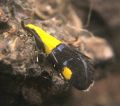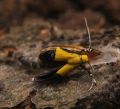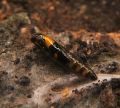2023 Annual Report for: Oecophoridae / Oecophorinae
For species seen in 2023 that had less than or equal to 100 records, full details are included; for more common species, the earliest, latest and highest count by vice-county are shown. The narrative for each species is taken from the main Hantsmoths website, and it is possible that some information on abundance and occurrence can get out of date, as it is impossible to keep up with all changes; however it should give a good introduction to each species. The tables in each species account summarise the previous status, and that for the current year.
For the maps, all records prior to 2023 are shown by a blue dot (the larger the dot, the more recent), with the current year's records shown in red. As previous records are superimposed on any report for 2023, new sites have greater emphasis (i.e. will show as 'more red').
In the species accounts, an asterisk next to a location indicates a new 10km square record; earliest ever dates are highlighted in orange, and latest ever in red. Initials in the species accounts refer to the recorders listed here. Please get in touch if you identify any omissions or errors, in particular if you have records that have yet to be submitted. Details of how to submit records can be found here.
28.008 [B&F: 0642a] Metalampra italica Baldizzone, 1977 - Migrant
An adventive species, which is spreading rapidly. On 17 August 2003, a worn specimen was found in a moth trap in a garden in Devon. The species had not previously been recorded outside Italy. Another specimen turned up in the same garden on 7 August 2004, and towards the end of July that year three specimens were found in and around a house at Welwyn, Hertfordshire, with one to a lighted window at Studham, Bedfordshire, on 3 July 2006. In Hampshire recorded for the first time at Over Wallop in August 2011. By 2016 there had been 19 reports, which had risen to over 100 three years later. It is now widespread across mainland Hampshire, and recorded from the Isle of Wight for the first time in 2020. Wingspan 13-14 mm. A similar species, M. cinnamomea, which occurs widely on the near continent and which is perhaps a more likely candidate to stray to the UK, has not occurred; neither species is prone to migration, and the origins of the British M. italica remain a mystery. Larva feeds within dead wood.
Records prior to 2023
| Vice County | #Records | #Individuals | First Record | Last Record |
|---|---|---|---|---|
| 10 | 8 | 8 | 2020 | 2022 |
| 11 | 224 | 261 | 2013 | 2022 |
| 12 | 77 | 92 | 2011 | 2022 |
2023 records
| Vice County | #Records | #Individuals | Max Quantity |
|---|---|---|---|
| 11 | 47 | 50 | 2 |
| 12 | 41 | 48 | 6 |
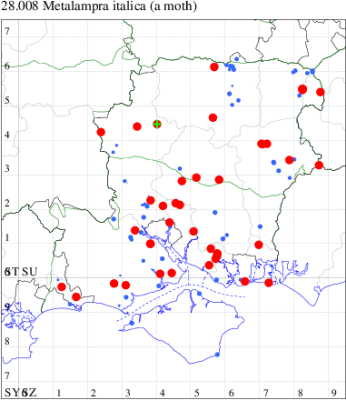
Records by year
Records by week (adult)
Records by week (larval)
Record Details
VC11: Marchwood, two, 22 Jun; one, 28 Jun; one, 15 Aug; one, 03 Sep; one, 17 Aug (CTha); Totton, one, 25 Jul (CNB); Romsey, one, 07 Jul (NRJ); Needs Ore NNR, one, 23 Jul (PCra); Blackfield, one, 19 Aug (SJJ); Swaythling, Southampton, one, 20 Jun; one, 17 Jul (MEdg); Chandler's Ford, one, 27 Jun; one, 01 Jul; one, 01 Sep (KArb); Allbrook, one, 21 Aug; one, 04 Sep; two, 08 Sep; one, 09 Sep; one, 23 Sep; Highbridge, Eastleigh, one, 05 Sep (SIng); Winchester, one, field observation, 06 Jul; one, 19 Aug (THW); Stubbington, one, 16 Jun (DPH); Funtley, one, 06 Sep (TDC); Fareham, one, 21 Aug; one, 05 Sep (IMcP); one, 14 Jun; one, 15 Jun; one, 21 Jun; one, 27 Jul; one, 16 Aug; two, 07 Sep; one, 09 Sep (MLO); one, to a lighted window, 08 Sep (KJW); Botley, one, 01 Aug (SLB); Waterlooville*, one, 03 Sep (DWhe); Hurn, one, 29 Jul; one, 10 Sep (MJef); Burton, nr Christchurch, one, 07 Jul; one, 16 Jul (JStw); Sway, one, 01 Sep; one, 04 Sep (SKee); Battramsley, NF, one, field observation, 28 Jul (RBW); Southsea, one, 23 Jun; one, 20 Jul; one, 10 Sep (JGdr); Eastoke, Hayling Island*, one, 16 Jun (STho);
VC12: Cholderton, one, 04 Sep; Anna Valley, Andover, one, 21 Aug; one, 02 Sep; one, 03 Sep; one, 08 Sep (TJN); Harewood Forest*, larva, one, field observation, 07 May; larva, one, field observation, 08 May (BGD); Morn Hill, Winchester, one, 08 Jul (CRB, PDF, DAS, LHur); Cheriton, one, field observation, 27 Jun (DAS); North Waltham, one, field observation, 25 Jun; two, 09 Aug (AJon); Great Haughurst Copse, Axmansford, one, 27 Aug (ACB); Alton, one, field observation, 29 Jun (CBec); one, to artificial light, 19 Jun; one, to artificial light, 22 Jun; one, 16 Jul (DBO); Windmill Hill, Chalton, one, 07 Jul (CJP); Whitehill, one, 07 Jul; one, 10 Jul; one, 25 Aug; one, 08 Sep (ASto); Hammer Vale, Woolmer, one, indoors, 28 Jun; one, 07 Jul; one, 14 Jul; one, indoors, 16 Jul; one, indoors, 18 Jul; one, indoors, 23 Jul; one, 27 Jul; one, indoors, 09 Aug; one, indoors, 13 Aug; one, indoors, 25 Aug; one, indoors, 28 Aug; two, 06 Sep (ASwa); Fleet Pond, one, field observation, 14 Jun; one, 17 Aug; one, 16 Sep; one, field observation, 03 Aug; one, 06 Sep; six, field observation, 24 Aug (MHals); Farnborough, one, 21 Jun; one, 24 Jun (KBW)
28.009 [B&F: 0648] White-shouldered House-moth Endrosis sarcitrella (Linnaeus, 1758) - Common
Common in houses, and around sheds and outhouses throughout the British Isles. Widespread and rather common in Hampshire and on the Isle of Wight. Wingspan 13-20 mm. A familiar and easily recognised inhabitant of many houses, distinguished from the more frequent Brown House Moth Hofmannophila pseudospretella by the white head and thorax. Larva feeds on detritus and refuse, as well as dried goods, such as cereals and grain.
Records prior to 2023
| Vice County | #Records | #Individuals | First Record | Last Record |
|---|---|---|---|---|
| 10 | 388 | 623 | 1850 | 2022 |
| 11 | 3637 | 4722 | 1971 | 2022 |
| 12 | 1153 | 1407 | 1977 | 2022 |
2023 records
| Vice County | #Records | #Individuals | Max Quantity |
|---|---|---|---|
| 11 | 137 | 158 | 4 |
| 12 | 65 | 77 | 3 |
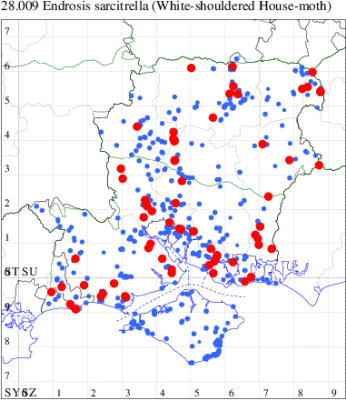
Records by year
Records by week (adult)
Records by week (larval)
Record Summary
VC11: Earliest: Marchwood, 20 Feb, 1 (TDCh) Latest: Southsea, 10 Oct, 2 (JGdr) Max count: Woodley, 05 Sep, 4 (NBin)
VC12: Earliest: Blackwater, 28 Mar, 1 (BGD) Latest: Alton, 22 Oct, 2 (DBO) Max count: Sherborne St John, 16 Jun, 3 (MJW)
28.010 [B&F: 0647] Brown House-moth Hofmannophila pseudospretella (Stainton, 1849) - Common
Common outdoors, in woodland, hedgerows and grassland, and indoors, in houses and barns, throughout the British Isles. Widespread and common in Hampshire and on the Isle of Wight. Wingspan 16-25 mm. A widespread and familiar insect, originally an inhabitant of Asia. Larva feeds on detritus and refuse, both animal and vegetable.
Records prior to 2023
| Vice County | #Records | #Individuals | First Record | Last Record |
|---|---|---|---|---|
| 10 | 519 | 803 | 1977 | 2022 |
| 11 | 5920 | 8975 | 1971 | 2022 |
| 12 | 2119 | 3666 | 1982 | 2022 |
2023 records
| Vice County | #Records | #Individuals | Max Quantity |
|---|---|---|---|
| 11 | 327 | 418 | 4 |
| 12 | 123 | 175 | 9 |
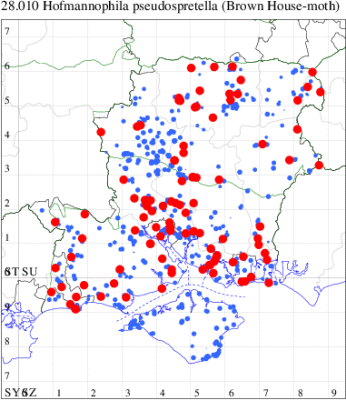
Records by year
Records by week (adult)
Records by week (larval)
Record Summary
VC11: Earliest: Horndean, 23 Apr, 1 (PHog) Latest: Southsea, 09 Oct, 1 (JGdr) Max count: Swaythling, Southampton, 20 Jun, 4 (MEdg)
VC12: Earliest: Whitehill, 14 May, 1 (ASto) Latest: Whitehill, 08 Oct, 1 (ASto) Max count: Basingstoke, 17 Jun, 9 (MJW)
28.012 [B&F: 0644] Borkhausenia fuscescens (Haworth, 1828) - Common
Common in woodland, hedgerows, farmland and farm buildings throughout the British Isles. In Hampshire widespread and reasonably common, but probably under-recorded on the Isle of Wight were reports have increased in recent years. Wingspan 9-12 mm. A consistent feature is the large, distinct discal stigma. Larva feeds on dead leaves, detritus in bird nests and vegetable waste, living within a silken case.
Records prior to 2023
| Vice County | #Records | #Individuals | First Record | Last Record |
|---|---|---|---|---|
| 10 | 67 | 91 | 1900 | 2022 |
| 11 | 540 | 694 | 1973 | 2022 |
| 12 | 117 | 141 | 1985 | 2022 |
2023 records
| Vice County | #Records | #Individuals | Max Quantity |
|---|---|---|---|
| 11 | 6 | 6 | 1 |
| 12 | 5 | 5 | 1 |

Records by year
Records by week (adult)
Records by week (larval)
Record Details
VC11: Portchester, one, 05 Jul (DH-J); Portsmouth, one, 09 Sep (IRT); Havant Crematorium, one, 02 Sep (JGdr); Hurn, one, 26 Jun (MJef); Sway, one, 09 Jun; one, 10 Jun (SKee);
VC12: Overton, one, 05 Sep (ACr); Basingstoke, one, 27 Jul (MJW); Hammer Vale, Woolmer, one, indoors, 07 Jul; one, indoors, 09 Jul; one, 16 Jul (ASwa)
28.013 [B&F: 0637] Crassa tinctella (Hübner, 1796) - Nationally Scarce B
Nationally scarce (Nb) in ancient woodland throughout much of southern Britain, from Kent to Devon in the south and Lincolnshire and North Wales in the north (MBGBI Vol 4 part 1). In Hampshire sparsely recorded in the south of the county, with only one recent record from the north and none from the Isle of Wight. Wingspan 14-16 mm. Resembles Batia unitella, but ochreous-orange rather than golden-brown, and lacks the contrasting orange head and palps of B. unitella; also, the costa is convex in B. unitella, straight in C. tinctella. Larva feeds on lichens growing on Willow.
Records prior to 2023
| Vice County | #Records | #Individuals | First Record | Last Record |
|---|---|---|---|---|
| 10 | 1 | 0 | 1900 | 1900 |
| 11 | 21 | 22 | 1972 | 2022 |
| 12 | 19 | 25 | 1975 | 2022 |
2023 records
| Vice County | #Records | #Individuals | Max Quantity |
|---|---|---|---|
| 11 | 1 | 1 | 1 |
| 12 | 2 | 2 | 1 |
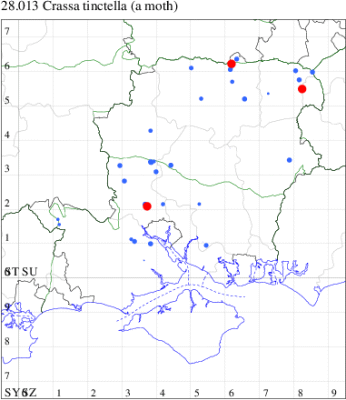
Records by year
Records by week (adult)
Records by week (larval)
Record Details
VC11: Romsey, one, 11 Jun (MJB);
VC12: Silchester Common, one, 10 Jun (MBot); Fleet Pond, one, 27 Jun (MHals)
28.014 [B&F: 0642] Crassa unitella (Hübner, 1796) - Common
Common wherever there are trees throughout southern England and Wales, north to Yorkshire. Widespread and common in Hampshire but rather scarce on the Isle of Wight. Wingspan 13-17 mm. Only confusable with the rare and local Crassa tinctella, which see. Larva feeds on fungi growing on and under the dead bark of various deciduous trees.
Records prior to 2023
| Vice County | #Records | #Individuals | First Record | Last Record |
|---|---|---|---|---|
| 10 | 155 | 215 | 1856 | 2022 |
| 11 | 1223 | 1542 | 1974 | 2022 |
| 12 | 878 | 1578 | 1971 | 2022 |
2023 records
| Vice County | #Records | #Individuals | Max Quantity |
|---|---|---|---|
| 11 | 82 | 99 | 5 |
| 12 | 51 | 57 | 2 |
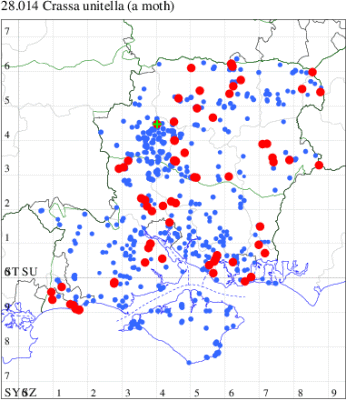
Records by year
Records by week (adult)
Records by week (larval)
Record Summary
VC11: Earliest: Culverley, NF, 30 May, 3 (CLew) Latest: Fareham, 22 Aug, 1 (MLO) Max count: Broughton, 22 Jun, 5 (GCE)
VC12: Earliest: Harewood Forest, 08 May, 1 (BGD) Latest: Overton, 25 Aug, 1 (FTu) Max count: Wonston, 16 Jun, 2 (GCE)
28.015 [B&F: 0640] Batia lunaris (Haworth, 1828) - Common
Common in woodland, plantations, parklands and urban areas throughout much of England and Wales. Widespread and common in Hampshire but rather scarce on the Isle of Wight. Wingspan 9-11 mm. Most likely to be confused with B. lambdella, which is mainly restricted to the coast, and B. internella, which is very restricted in its range; see these species accounts for details. Larva feeds on lichens growing on trees, fence posts, and in rotten wood under the bark.
Records prior to 2023
| Vice County | #Records | #Individuals | First Record | Last Record |
|---|---|---|---|---|
| 10 | 64 | 85 | 1900 | 2022 |
| 11 | 791 | 957 | 1974 | 2022 |
| 12 | 252 | 376 | 1980 | 2022 |
2023 records
| Vice County | #Records | #Individuals | Max Quantity |
|---|---|---|---|
| 11 | 42 | 57 | 5 |
| 12 | 15 | 21 | 4 |
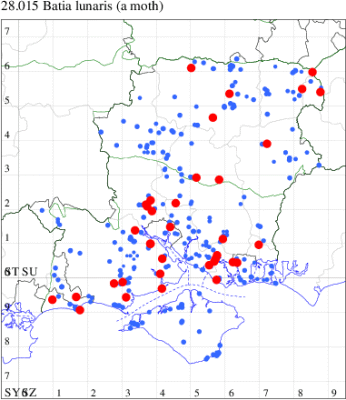
Records by year
Records by week (adult)
Records by week (larval)
Record Details
VC11: Marchwood, three, 24 Jun; one, 11 Jul; one, 20 Jun; two, 22 Jun; one, 24 Jun; two, 30 Jun; one, 27 Jul (CTha); Totton, one, 23 Jun (CNB); North Baddesley, two, 22 Jun (RWPas); Romsey, one, 10 Jun; one, 08 Jul (KPea); one, 19 Jun; one, 23 Jun (MJB); one, 26 Jun; five, 07 Jul (NRJ); Needs Ore NNR, one, 02 Jul (PCra); Dibden Purlieu, NF, one, 27 Jun (RAC); Bitterne Park, Southampton, one, 07 Jul (MGP); Allbrook, one, 07 Jul (SIng); Stubbington, two, 10 Jun; one, 24 Jun (DPH); Fareham, one, 27 Jun (ADT); one, 26 Jun (IMcP); one, 22 Jun (MLO); Wickham, one, 27 Jun (JRDS); Portchester, one, 24 Jun (DH-J); Horsea Island, one, netted, 16 Jun (KJW det. RJD); Waterlooville, one, 12 Jul (DWhe); Bournemouth*, three, 07 Jul (WSoa, SMorr); Burton, nr Christchurch, one, 16 Jun; two, 27 Jun; one, 30 Jun (JStw); Hengistbury Head, two, 27 Jun (MJef); Sway, one, 22 Jun; one, 28 Jun; two, 07 Jul (SKee); Battramsley, NF, one, 11 Jun (MWelf det. MJW); Pennington, one, 21 Jun; one, 23 Jun (RFC); Needs Ore NNR, one, 10 Jun; one, 01 Jul (CNB); Browndown, one, field observation, 02 Jul (IHrg);
VC12: Morn Hill, Winchester, three, 08 Jul (CRB, PDF, DAS, LHur); Cheriton, one, field observation, 27 Jun (DAS); North Waltham, one, 29 Jun; one, 07 Jul (AJon); Ecchinswell, one, 07 Jul (MJN); Basingstoke, one, 27 Jun (MJW); Windmill Hill, Chalton, one, 01 Jul; one, 07 Jul (CJP); Fleet Pond, one, 27 Jun; one, 27 Jun (MHals); Blackwater, one, 17 Jun; one, 27 Jun; one, 07 Jul (BGD); Farnborough, two, 24 Jun; four, 27 Jun (KBW)
28.017 [B&F: 0641] Batia lambdella (Donovan, 1793) - Local
Local on heathland, scrub and open woodland throughout the British Isles, more numerous in the south. In Hampshire fairly common on the south coast and around the New Forest, and still reported occasionally from around Totland on the Isle of Wight, but not recorded in north Hampshire to date. Wingspan 13-18 mm. The main confusion species are B. lunaris, from which differs in coloration rather more orange-tinged, costal suffusion narrower, base of dorsum not darker than ground colour, triangular base of black lambda mark merging more gradually to upper process which is relatively broader; and B. internella, which see. Larva feeds within bark of Gorse
Records prior to 2023
| Vice County | #Records | #Individuals | First Record | Last Record |
|---|---|---|---|---|
| 10 | 15 | 14 | 1893 | 2020 |
| 11 | 149 | 142 | 1974 | 2022 |
| 12 | 7 | 17 | 2010 | 2020 |
2023 records
| Vice County | #Records | #Individuals | Max Quantity |
|---|---|---|---|
| 11 | 6 | 8 | 3 |
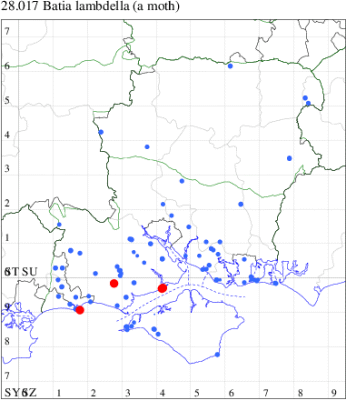
Records by year
Records by week (adult)
Records by week (larval)
Record Details
VC11: Hengistbury Head, one, 27 Jun (MJef); Sway, one, 07 Jul (SKee); Needs Ore NNR, three, 10 Jun; one, 16 Jun (CNB); one, 01 Jul; one, 24 Jul (PCra)
28.019 [B&F: 0649] Esperia sulphurella (Fabricius, 1775) - Common
Common in woodland, hedgerows and gardens throughout the British Isles, north to central Scotland. Widespread and common in Hampshire and on the Isle of Wight. Wingspan 12-15 mm. Day-flying, although may come to light. Unmistakable. Larva feeds in the decaying wood and associated fungi of many native deciduous trees.
Records prior to 2023
| Vice County | #Records | #Individuals | First Record | Last Record |
|---|---|---|---|---|
| 10 | 101 | 108 | 1856 | 2022 |
| 11 | 657 | 729 | 1971 | 2022 |
| 12 | 244 | 294 | 1973 | 2022 |
2023 records
| Vice County | #Records | #Individuals | Max Quantity |
|---|---|---|---|
| 11 | 20 | 24 | 3 |
| 12 | 9 | 9 | 1 |
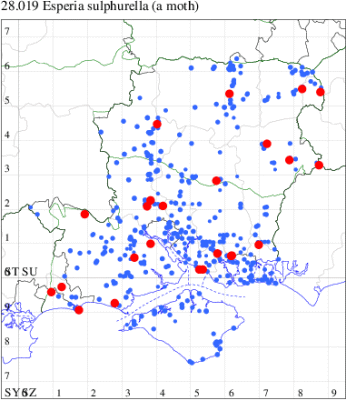
Records by year
Records by week (adult)
Records by week (larval)
Record Details
VC11: Hale Purlieu, NF*, one, field observation, 29 Apr; one, field observation, 06 May; one, field observation, 14 May (JPuz); Denny Wood, NF, one, field observation, 22 May (DAS); Marchwood, one, 30 Apr; one, 19 May (CTha); Romsey, one, 28 Apr (MJB); one, 24 May (NRJ); Chandler's Ford, one, 12 May (KArb); Brownwich Cliffs, three, field observation, 03 May; Titchfield, one, field observation, 04 May (IHrg); Fareham, two, field observation, 17 Apr (KJW); Portsdown, one, seen by day, 22 May; one, seen by day, 22 May (RJD); Waterlooville, one, 27 May (DWhe); Muscliffe*, two, 10 May; one, 29 May (KingB); Hurn, one, 16 May; Hengistbury Head, one, 04 May (MJef); Blackbush, Milford-on-Sea, one, 27 May (MBot);
VC12: Harewood Forest, one, field observation, 07 May (BGD); Cheriton, one, field observation, 15 May (DAS); Basingstoke, one, 10 May (MJW); Windmill Hill, Chalton, one, 08 May (CJP); Whitehill, one, 28 Apr (ASto); Hammer Vale, Woolmer, one, field observation, 12 May; one, indoors, 26 May (ASwa); Fleet Pond, one, 04 May (MHals); Farnborough, one, field observation, 04 May (KBW)
28.020 [B&F: 0650] Dasycera oliviella (Fabricius, 1794) - Nationally Scarce A
Nationally scarce (Na) in ancient woodland, especially where there are open areas with dead wood, and restricted to the south-east of England. In Hampshire the only recent records are from Harewood Forest and Ashurst. Not recorded from the Isle of Wight to date. Wingspan 14-17 mm. Unmistakable. Day-flying. Larva feeds within bark of Oak, Hazel, Blackthorn and Pear.
Records prior to 2023
| Vice County | #Records | #Individuals | First Record | Last Record |
|---|---|---|---|---|
| 11 | 51 | 60 | 1977 | 2022 |
| 12 | 5 | 4 | 1981 | 2019 |
2023 records
| Vice County | #Records | #Individuals | Max Quantity |
|---|---|---|---|
| 11 | 4 | 4 | 1 |
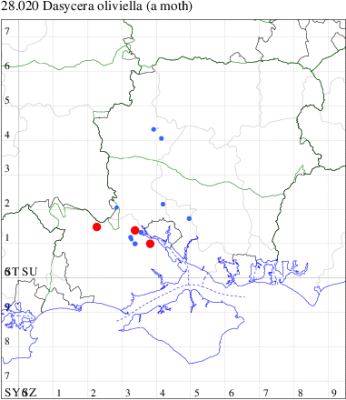
Records by year
Records by week (adult)
Records by week (larval)
Record Details
VC11: Eyeworth Wood, NF*, one, field observation, 12 Jun (CEas); Marchwood, one, 02 Aug (CTha); Totton, one, 03 Jul; one, 07 Aug (CNB)
28.021 [B&F: 0651] Oecophora bractella (Linnaeus, 1758) - Nationally Scarce A
Nationally scarce (Na) in ancient woodland in parts of southern England and southern Wales. In Hampshire larvae of this species were discovered in the spring of 1983 in habitat similar to that of E. oliviella, in Harewood Forest; this remains the only known locality in the county for this very rare and local species. Not recorded from the Isle of Wight to date. Wingspan 12-17 mm. Flies from dawn to sunrise and, less often, after dark, when occasional at light. Larva feeds on dead wood and various fungi.
Records prior to 2023
| Vice County | #Records | #Individuals | First Record | Last Record |
|---|---|---|---|---|
| 11 | 1 | 1 | 2015 | 2015 |
| 12 | 12 | 12 | 1983 | 2013 |
2023 records
| Vice County | #Records | #Individuals | Max Quantity |
|---|---|---|---|
| 12 | 1 | 1 | 1 |
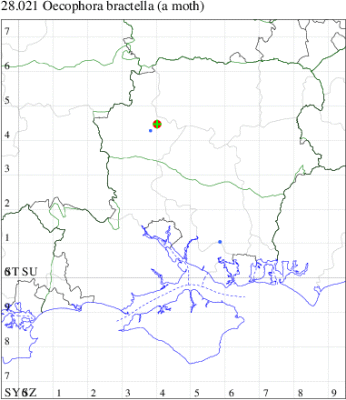
Records by year
Records by week (adult)
Records by week (larval)
Record Details
VC12: Harewood Forest, larva, one, field observation, 08 May (BGD)
28.022 [B&F: 0652] Alabonia geoffrella (Linnaeus, 1767) - Common
Common in woodland, hedgerows and gardens throughout England and Wales. Widespread in Hampshire and on the Isle of Wight, where often seen during the day in deciduous woodland in small numbers. Wingspan 18-21 mm. Day-flying, but may come to light. Unmistakable. Larva feeds within the bark of rotten wood.
Records prior to 2023
| Vice County | #Records | #Individuals | First Record | Last Record |
|---|---|---|---|---|
| 10 | 121 | 162 | 1856 | 2022 |
| 11 | 202 | 229 | 1972 | 2022 |
| 12 | 115 | 191 | 1974 | 2022 |
2023 records
| Vice County | #Records | #Individuals | Max Quantity |
|---|---|---|---|
| 11 | 13 | 15 | 2 |
| 12 | 3 | 3 | 1 |
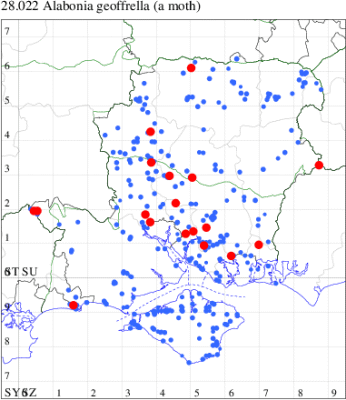
Records by year
Records by week (adult)
Records by week (larval)
Record Details
VC11: Lee Drove, Romsey, one, field observation, 27 May; Cromarty Pond area, Lord's Hill, one, field observation, 22 May (JClx); Winter Down Copse, King's Somborne, one, field observation, 22 May (AJB); Wildern LNR, Hedge End, one, field observation, 18 May (TCrw det. RTof); Crab Wood, Winchester, two, field observation, 31 May (DAS); Allbrook, one, 09 Jun (SIng); Botley Wood, one, field observation, 18 Jun (DPH); Botley, one, 08 Jun (SLB); Curdridge, present, field observation, 27 May (iNat); Portsdown, one, netted, 22 May (KJW); Waterlooville, two, 09 Jun (DWhe); Hengistbury Head, two, 12 Jun (MJef);
VC12: Harewood Forest*, one, field observation, 30 May (CLew); Magdalen Hill Down NNR, one, 10 Jun (KArb, SIng, PPea); Ecchinswell, one, field observation, 02 Jun (MJN); Hammer Vale, Woolmer, one, field observation, 04 Jun (ASwa)
28.024 [B&F: 0656] Tachystola acroxantha (Meyrick, 1885) - Local
Naturalised and increasing, through accidental introduction in garden plants from Australia, throughout much of southern England, north to Lancashire; until recently only known from south-west England, this is a species which appears to have undergone a rapid range expansion. Since 1997, recorded frequently in Fleet, and since 2002 increasingly common along the south coast. Wingspan 13-18mm. The pinkish orange termen make this an unmistakable species. Larva feeds on fallen leaves and leaf litter. The pRDB3 status often indicated for this species is a misnomer and should be ignored.
Records prior to 2023
| Vice County | #Records | #Individuals | First Record | Last Record |
|---|---|---|---|---|
| 10 | 825 | 2419 | 2002 | 2022 |
| 11 | 5451 | 10511 | 1994 | 2022 |
| 12 | 883 | 2321 | 1997 | 2022 |
2023 records
| Vice County | #Records | #Individuals | Max Quantity |
|---|---|---|---|
| 11 | 634 | 1348 | 18 |
| 12 | 150 | 337 | 19 |
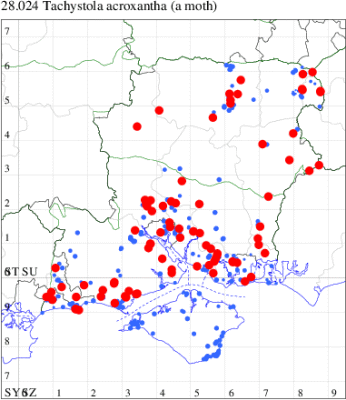
Records by year
Records by week (adult)
Records by week (larval)
Record Summary
VC11: Earliest: Southsea, 14 Apr, 1 (JGdr) Latest: Sway, 22 Nov, 1 (SKee) Max count: Portchester, 03 Sep, 18 (DH-J)
VC12: Earliest: Farnborough, 09 Apr, 1 (KBW) Latest: North Waltham, 22 Nov, 1 (AJon) Max count: North Waltham, 01 Oct, 19 (AJon)
28.025 [B&F: 0654] Pleurota bicostella (Clerck, 1759) - Local
Local on moorland and heathland throughout the British Isles. In Hampshire rather infrequently recorded on the heaths of the New Forest and in the north-east of the county, but remaining extremely rare on the Isle of Wight. Wingspan 23-25 mm. Large labial palps, with upward pointing tips, white costal streak and pair of small black discal spots; superficially similar to Sophronia semicostella, which lacks the two discal spots. Larva feeds on Bell Heather and Cross-leaved Heath, living within a silken web.
Records prior to 2023
| Vice County | #Records | #Individuals | First Record | Last Record |
|---|---|---|---|---|
| 10 | 3 | 2 | 1974 | 2007 |
| 11 | 115 | 163 | 1971 | 2022 |
| 12 | 19 | 42 | 1980 | 2020 |
2023 records
| Vice County | #Records | #Individuals | Max Quantity |
|---|---|---|---|
| 11 | 3 | 1 | 1 |
| 12 | 1 | 2 | 2 |
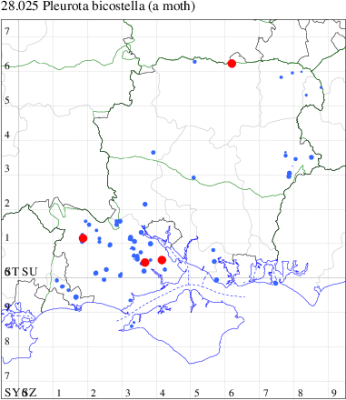
Records by year
Records by week (adult)
Records by week (larval)
Record Details
VC11: Ogden's Purlieu, NF, one, 17 Jun (AMD); Culverley, NF, present, field observation, 30 May (CLew); Fawley Inclosure, NF, present, field observation, 20 May (RAC);
VC12: Silchester Common, two, field observation, flushed from Heath. , 10 Jun (WLan)


